The Role of Human Resource Management in Agricultural Labor-Saving Technologies: An Integrative Review and Science Mapping
Abstract
:1. Introduction
- (1)
- What are the trend topics and emerging themes in the field?
- (2)
- How has the thematic progressed during the 2013–2023 period in the field?
- (3)
- What practical recommendations and future research directions can be drawn that can address the role of HRM in the adoption of labor-saving technology in agriculture?
- Section 2 provides a comprehensive review of the literature, research gap, and the expected outcomes;
- Section 3 describes the research strategy process and explains the integrative review method;
- Section 4 comprises broad results and discussions on elements impacting the integration of HRM roles, as well as emerging and trending topics. These are further summarized in the form of a conceptual framework and the practical implications.
- Section 5 states the conclusions, future directions, and limitations of our research.
2. Literature Review
3. Materials and Methodology
3.1. Materials
3.2. Methodology
4. Results and Discussions
4.1. Annual Scientific Production
4.2. A Contextual Word Cloud and Overlapping of Keywords
4.3. Trend Topics and Thematic Mapping
4.4. Thematic Progression Analysis
4.4.1. Factors Influenced by Management (Structure, Strategy, and Systems)
4.4.2. Factors Influenced by Corporate Culture (Skills, Staff, Style)
5. Conclusions
Author Contributions
Funding
Data Availability Statement
Conflicts of Interest
Abbreviations
| HR | Human Resources |
| HRM | Human Resource Management |
| UN | United Nations |
| ICTs | Information and Communication Technology |
| IT | Information Technology |
| SFTs | Sustainable Farming Technologies |
| SDGs | Sustainable Development Goals |
| IoTs | Internet of Things |
| ML | Machine Learning |
Appendix A
| Main Query | TITLE-ABS-KEY (“Technology Adoption” AND “Human Resources” OR “Human Resource Management” OR “hr” OR “hrm” OR “Agricultural Labor” OR “Agriculture Workforce” OR “Agricultural Employment”) | |
|---|---|---|
| Inclusion | Language | English Language |
| Subject area | Agricultural and Biological Sciences; Social Sciences; Economics and Econometrics; Business, Management and Accounting; Decision Sciences. | |
| Document type | Articles, reviews, conference papers | |
| Period | 2013–2023 (PUBYEAR > 2012 AND PUBYEAR < 2024) | |
| Exclusion | Document type | Book chapter (3), short survey (4) |
| Language | Chinese (3), Spanish (2), Japanese (1) | |
| Subject area | Environmental Science; Computer Science; Engineering; Psychology; Medicine; Energy; Mathematics; Earth and Planetary Sciences; Art and Humanities; Biochemistry; Genetics and Molecular biology; Physics and Astronomy; Material Sciences; Health Professions; Chemical Engineering. | |
References
- Nagy, S. Románia Mezőgazdaságának Vizsgálata, Különös Tekintettel Az EU-Csatlakozás Utáni Időszakra. Acta Carolus Robertus 2021, 11, 95–107. [Google Scholar] [CrossRef]
- United Nations. The Sustainable Development Goals Report 2023: Special Edition. 2023. Available online: https://www.un.org/sustainabledevelopment/hunger/ (accessed on 1 April 2024).
- Schmitz, A.; Moss, C.B. Mechanized Agriculture: Machine Adoption, Farm Size, and Labor Displacement. 2015. Available online: https://hdl.handle.net/10355/48143 (accessed on 1 April 2024).
- Curry, G.N.; Nake, S.; Koczberski, G.; Oswald, M.; Rafflegeau, S.; Lummani, J.; Peter, E.; Nailina, R. Disruptive Innovation in Agriculture: Socio-Cultural Factors in Technology Adoption in the Developing World. J. Rural Stud. 2021, 88, 422–431. [Google Scholar] [CrossRef]
- Ferrari, A.; Bacco, M.; Gaber, K.; Jedlitschka, A.; Hess, S.; Kaipainen, J.; Koltsida, P.; Toli, E.; Brunori, G. Drivers, Barriers and Impacts of Digitalisation in Rural Areas from the Viewpoint of Experts. Inf. Softw. Technol. 2022, 145, 106816. [Google Scholar] [CrossRef]
- Javaid, M.; Haleem, A.; Singh, R.P.; Suman, R. Enhancing Smart Farming through the Applications of Agriculture 4.0 Technologies. Int. J. Intell. Netw. 2022, 3, 150–164. [Google Scholar] [CrossRef]
- Trienekens, J.H. Agricultural Value Chains in Developing Countries a Framework for Analysis. Int. Food Agribus. Manag. Rev. 2011, 14, 51–82. [Google Scholar] [CrossRef]
- Ganeshkumar, C.; Singh, N.K.; Mor, R.S.; Panghal, A. Investigating the Adoption Barriers to Industry 4.0 Technologies in Farmer Producer Organisations. Int. J. Glob. Bus. Compet. 2023, 18, 162–174. [Google Scholar] [CrossRef]
- Tovstiga, G. Strategy in Practice: A Practitioner’s Guide to Strategic Thinking, 3rd ed.; John Wiley & Sons: Hoboken, NJ, USA, 2015. [Google Scholar]
- Biron, M.; De Cieri, H.; Fulmer, I.; Lin, C.H.V.; Mayrhofer, W.; Nyfoudi, M.; Sanders, K.; Shipton, H.; Sun, J.M. Structuring for Innovative Responses to Human Resource Challenges: A Skunk Works Approach. Hum. Resour. Manag. Rev. 2021, 31, 100768. [Google Scholar] [CrossRef]
- Ahammad, M.F.; Basu, S.; Munjal, S.; Clegg, J.; Shoham, O.B. Strategic Agility, Environmental Uncertainties and International Performance: The Perspective of Indian Firms. J. World Bus. 2021, 56, 101218. [Google Scholar] [CrossRef]
- Doz, Y. Fostering Strategic Agility: How Individual Executives and Human Resource Practices Contribute. Hum. Resour. Manag. Rev. 2020, 30, 100693. [Google Scholar] [CrossRef]
- Alerasoul, S.A.; Afeltra, G.; Hakala, H.; Minelli, E.; Strozzi, F. Organisational Learning, Learning Organisation, and Learning Orientation: An Integrative Review and Framework. Hum. Resour. Manag. Rev. 2022, 32, 100854. [Google Scholar] [CrossRef]
- Anwar, G.; Abdullah, N.N. The Impact of Human Resource Management Practice on Organizational Performance. Int. J. Eng. Bus. Manag. (IJEBM) 2021, 13, 5. Available online: https://ssrn.com/abstract=3824689 (accessed on 1 April 2024). [CrossRef]
- Dhanpat, N.; Buthelezi, Z.P.; Joe, M.R.; Maphela, T.V.; Shongwe, N. Industry 4.0: The Role of Human Resource Professionals. SA J. Hum. Resour. Manag. 2020, 18, 1–11. Available online: https://hdl.handle.net/10520/EJC-1fa43205e3 (accessed on 1 April 2024). [CrossRef]
- Rehman, J.; Hawryszkiewycz, I.; Sohaib, O.; Soomro, A.M. Developing Intellectual Capital in Professional Service Firms using High Performance Work Practices as Toolkit. In Proceedings of the 53rd Annual Hawaii International Conference on System Sciences, HICSS 2020, Maui, HI, USA, 7–10 January 2020; IEEE: Piscataway, NJ, USA, 2020. [Google Scholar]
- Blanka, C.; Krumay, B.; Rueckel, D. The Interplay of Digital Transformation and Employee Competency: A Design Science Approach. Technol. Forecast. Soc. Chang. 2022, 178, 121575. [Google Scholar] [CrossRef]
- Kaliannan, M.; Darmalinggam, D.; Dorasamy, M.; Abraham, M. Inclusive Talent Development as a Key Talent Management Approach: A Systematic Literature Review. Hum. Resour. Manag. Rev. 2023, 33, 100926. [Google Scholar] [CrossRef]
- Vahdat, S. The Role of IT-Based Technologies on the Management of Human Resources in the COVID-19 Era. Kybernetes 2022, 51, 2065–2088. [Google Scholar] [CrossRef]
- Jaiswal, A.; Arun, C.J.; Varma, A. Rebooting Employees: Upskilling for Artificial Intelligence in Multinational Corporations. Int. J. Hum. Resour. Manag. 2022, 33, 1179–1208. [Google Scholar] [CrossRef]
- Akinnusi, D.M.; Sonubi, O.O.; Oyewunmi, A.E. Fostering Effective Workforce Diversity Management in Nigerian Organizations: The Challenge of Human Resource Management. Int. Rev. Manag. Mark. 2017, 7, 108–116. [Google Scholar]
- Šūmane, S.; Kunda, I.; Knickel, K.; Strauss, A.; Tisenkopfs, T.; des Ios Rios, I.; Rivera, M.; Chebach, T.; Ashkenazy, A. Local and Farmers’ Knowledge Matters! how Integrating Informal and Formal Knowledge Enhances Sustainable and Resilient Agriculture. J. Rural Stud. 2018, 59, 232–241. [Google Scholar] [CrossRef]
- Charatsari, C.; Michailidis, A.; Lioutas, E.D.; Bournaris, T.; Loizou, E.; Paltaki, A.; Lazaridou, D. Competencies Needed for Guiding the Digital Transition of Agriculture: Are Future Advisors Well-Equipped? Sustainability 2023, 15, 15815. [Google Scholar] [CrossRef]
- Senapathy, M.; Pandikumar, M. Application of Knowledge Management Approach on Agricultural Development in Developing Countries. J. Manag. Train. Ind. 2019, 6, 17–38. [Google Scholar] [CrossRef]
- Opolot, H.N.; Isubikalu, P.; Obaa, B.B.; Ebanyat, P. Influence of University Entrepreneurship Training on Farmers’ Competences for Improved Productivity and Market Access in Uganda. Cogent Food Agric. 2018, 4, 1469211. [Google Scholar] [CrossRef]
- Fonseca, L.; Nieth, L. The Role of Universities in Regional Development Strategies: A Comparison Across Actors and Policy Stages. Eur. Urban Reg. Stud. 2021, 28, 298–315. [Google Scholar] [CrossRef]
- Mabić, M.; Garbin Praničević, D.; Gašpar, D. Toward Regional Development: Digital Transformation of Higher Education Institutions. Croat. Reg. Dev. J. 2022, 3, 1–14. [Google Scholar] [CrossRef]
- Pozsár, D.K. RUNIN–Az Európai Unió Regionális Gazdaságfejlesztési Kísérlete a Felsőoktatási Szektor Célzott Támogatásával. Tudásmenedzsment 2023, 24, 33–44. [Google Scholar] [CrossRef]
- Nyakudya, S.; Jambo, N.; Madududu, P.; Manyise, T. Unlocking the Potential: Challenges and Factors Influencing the use of ICTs by Smallholder Maize Farmers in Zimbabwe. Cogent Econ. Financ. 2024, 12, 2330431. [Google Scholar] [CrossRef]
- Ninh, L.K. Economic Role of Education in Agriculture: Evidence from Rural Vietnam. J. Econ. Dev. 2021, 23, 47–58. [Google Scholar] [CrossRef]
- Hailu, A.T. The Role of University–industry Linkages in Promoting Technology Transfer: Implementation of Triple Helix Model Relations. J. Innov. Entrep. 2024, 13, 25. [Google Scholar] [CrossRef]
- Compagnucci, L.; Spigarelli, F. The Third Mission of the University: A Systematic Literature Review on Potentials and Constraints. Technol. Forecast. Soc. Chang. 2020, 161, 120284. [Google Scholar] [CrossRef]
- Altalb, A.A.T.; Filipek, T.; Skowron, P. The Role of Agricultural Extension in the Transfer and Adoption of Agricultural Technologies. Asian J. Agric. Food Sci. 2015, 3, 500–507. [Google Scholar]
- Taylor, M.; Bhasme, S. Model Farmers, Extension Networks and the Politics of Agricultural Knowledge Transfer. J. Rural Stud. 2018, 64, 1–10. [Google Scholar] [CrossRef]
- Civera, C.; De Colle, S.; Casalegno, C. Stakeholder Engagement through Empowerment: The Case of Coffee Farmers. Bus. Ethics A Eur. Rev. 2019, 28, 156–174. [Google Scholar] [CrossRef]
- Akkermans, J.; Collings, D.G.; da Motta Veiga, S.P.; Post, C.; Seibert, S. Toward a Broader Understanding of Career Shocks: Exploring Interdisciplinary Connections with Research on Job Search, Human Resource Management, Entrepreneurship, and Diversity. J. Vocat. Behav. 2021, 126, 103563. [Google Scholar] [CrossRef]
- Baas, J.; Schotten, M.; Plume, A.; Côté, G.; Karimi, R. Scopus as a Curated, High-Quality Bibliometric Data Source for Academic Research in Quantitative Science Studies. Quant. Sci. Stud. 2020, 1, 377–386. [Google Scholar] [CrossRef]
- Page, M.J.; McKenzie, J.E.; Bossuyt, P.M.; Boutron, I.; Hoffmann, T.C.; Mulrow, C.D.; Shamseer, L.; Tetzlaff, J.M.; Akl, E.A.; Brennan, S.E.; et al. The PRISMA 2020 Statement: An Updated Guideline for Reporting Systematic Reviews. BMJ 2021, 372, n71. [Google Scholar] [CrossRef] [PubMed]
- Whittemore, R.; Knafl, K. The Integrative Review: Updated Methodology. J. Adv. Nurs. 2005, 52, 546–553. [Google Scholar] [CrossRef] [PubMed]
- Pandey, J. Factors Affecting Job Performance: An Integrative Review of Literature. Manag. Res. Rev. 2019, 42, 263–289. [Google Scholar] [CrossRef]
- Sirgy, M.J.; Lee, D.J. Work-Life Balance: An Integrative Review. Appl. Res. Qual. Life 2018, 13, 229–254. [Google Scholar] [CrossRef]
- Hopia, H.; Latvala, E.; Liimatainen, L. Reviewing the Methodology of an Integrative Review. Scand. J. Caring Sci. 2016, 30, 662–669. [Google Scholar] [CrossRef] [PubMed]
- Toronto, C.E.; Remington, R. A Step-by-Step Guide to Conducting an Integrative Review; Springer: Berlin/Heidelberg, Germany, 2020. [Google Scholar] [CrossRef]
- Russell, C.L. An Overview of the Integrative Research Review. Prog. Transplant. 2005, 15, 8–13. [Google Scholar] [CrossRef] [PubMed]
- Aria, M.; Cuccurullo, C. Bibliometrix: An R-Tool for Comprehensive Science Mapping Analysis. J. Informetr. 2017, 11, 959–975. [Google Scholar] [CrossRef]
- Derviş, H. Bibliometric Analysis using Bibliometrix an R Package. J. Scientometr. Res. 2019, 8, 156–160. [Google Scholar] [CrossRef]
- Peters, T.J.; Waterman, R.H., Jr. In Search of Excellence; Harper and Row: New York, NY, USA, 2006. [Google Scholar]
- Malanski, P.D.; Schiavi, S.; Dedieu, B. Characteristics of “work in agriculture” scientific communities. A bibliometric review. Agron. Sustain. Dev. 2019, 39, 36. [Google Scholar] [CrossRef]
- Sima, V.; Gheorghe, I.G.; Subić, J.; Nancu, D. Influences of the industry 4.0 revolution on the human capital development and consumer behavior: A systematic review. Sustainability 2020, 12, 4035. [Google Scholar] [CrossRef]
- Masere, T.P.; Worth, S.H. Factors influencing adoption, innovation of new technology and decision-making by small-scale resource constrained farmers: The perspective of farmers in lower Gweru, Zimbabwe. Afr. J. Food Agric. Nutr. Dev. 2022, 22, 20013–20035. [Google Scholar] [CrossRef]
- Czibere, I.; Kovách, I.; Loncsák, N. Hungarian Farmers and the Adoption of Precision Farming. Eur. Countrys. 2023, 15, 366–380. [Google Scholar] [CrossRef]
- Christiaensen, L.; Rutledge, Z.; Taylor, J.E. The future of work in agri-food. Food Policy 2021, 99, 101963. [Google Scholar] [CrossRef] [PubMed]
- Wossen, T.; Berger, T.; Di Falco, S. Social capital, risk preference and adoption of improved farm land management practices in Ethiopia. Agric. Econ. 2015, 46, 81–97. [Google Scholar] [CrossRef]
- Ruzzante, S.; Labarta, R.; Bilton, A. Adoption of agricultural technology in the developing world: A meta-analysis of the empirical literature. World Dev. 2021, 146, 105599. [Google Scholar] [CrossRef]
- Vemireddy, V.; Choudhary, A. A systematic review of labor-saving technologies: Implications for women in agriculture. Glob. Food Secur. 2021, 29, 100541. [Google Scholar] [CrossRef]
- Agussabti, A.; Rahmaddiansyah, R.; Hamid, A.H.; Zakaria, Z.; Munawar, A.A.; Abu Bakar, B. Farmers’ perspectives on the adoption of smart farming technology to support food farming in Aceh Province, Indonesia. Open Agric. 2022, 7, 857–870. [Google Scholar] [CrossRef]
- Dhraief, M.Z.; Bedhiaf, S.; Dhehibi, B.; Oueslati-Zlaoui, M.; Jebali, O.; Ben-Youssef, S. Factors affecting innovative technologies adoption by livestock holders in arid area of Tunisia. New Medit Mediterr. J. Econ. Agric. Environ. Rev. Mediterraneenne Dʹeconomie Agric. Environ. 2019, 18, 4. [Google Scholar] [CrossRef]
- Mishra, K.; Sam, A.G.; Diiro, G.M.; Miranda, M.J. Gender and the dynamics of technology adoption: Empirical evidence from a household-level panel data. Agric. Econ. 2020, 51, 857–870. [Google Scholar] [CrossRef]
- Qorri, D.; Felfoeldi, J. Research Trends in Agricultural Marketing Cooperatives: A Bibliometric Review. Agriculture 2024, 14, 199. [Google Scholar] [CrossRef]
- Juhdi, N.; Pa’wan, F.; Hansaram, R.M.K. HR practices and turnover intention: The mediating roles of organizational commitment and organizational engagement in a selected region in Malaysia. Int. J. Hum. Resour. Manag. 2013, 24, 3002–3019. [Google Scholar] [CrossRef]
- Hay, R.; Pearce, P. Technology adoption by rural women in Queensland, Australia: Women driving technology from the homestead for the paddock. J. Rural Stud. 2014, 36, 318–327. [Google Scholar] [CrossRef]
- Pindado, E.; Sánchez, M. Researching the entrepreneurial behaviour of new and existing ventures in European agriculture. Small Bus. Econ. 2017, 49, 421–444. [Google Scholar] [CrossRef]
- Seuneke, P.; Bock, B.B. Exploring the roles of women in the development of multifunctional entrepreneurship on family farms: An entrepreneurial learning approach. NJAS Wagening. J. Life Sci. 2015, 74, 41–50. [Google Scholar] [CrossRef]
- Chatterjee, S.; Gupta, S.D.; Upadhyay, P. Technology adoption and entrepreneurial orientation for rural women: Evidence from India. Technol. Forecast. Soc. Chang. 2020, 160, 120236. [Google Scholar] [CrossRef]
- Bustos, P.; Caprettini, B.; Ponticelli, J. Agricultural Productivity and Structural Transformation: Evidence from Brazil. Am. Econ. Rev. 2016, 106, 1320–1365. [Google Scholar] [CrossRef]
- Deininger, K.; Jin, S.; Xia, F.; Huang, J. Moving off the farm: Land institutions to facilitate structural transformation and agricultural productivity growth in China. World Dev. 2014, 59, 505–520. [Google Scholar] [CrossRef]
- Läpple, D.; Renwick, A.; Thorne, F. Measuring and understanding the drivers of agricultural innovation: Evidence from Ireland. Food Policy 2015, 51, 1–8. [Google Scholar] [CrossRef]
- Xayavong, V.; Kingwell, R.; Islam, N. How training and innovation link to farm performance: A structural equation analysis. Aust. J. Agric. Resour. Econ. 2016, 60, 227–242. [Google Scholar] [CrossRef]
- Nehrey, M.; Zomchak, L. Digital Technology: Emerging Issue for Agriculture. In Advances in Artificial Systems for Logistics Engineering. ICAILE 2022; Hu, Z., Zhang, Q., Petoukhov, S., He, M., Eds.; Lecture Notes on Data Engineering and Communications Technologies; Springer: Cham, Switzerland, 2022; Volume 135. [Google Scholar] [CrossRef]
- Tufa, A.H.; Alene, A.D.; Cole, S.M.; Manda, J.; Feleke, S.; Abdoulaye, T.; Chikoye, D.; Manyong, V. Gender differences in technology adoption and agricultural productivity: Evidence from Malawi. World Dev. 2022, 159, 106027. [Google Scholar] [CrossRef]
- Lin, B.; Fei, R. Analyzing inter-factor substitution and technical progress in the Chinese agricultural sector. Eur. J. Agron. 2015, 66, 54–61. [Google Scholar] [CrossRef]
- Mahlberg, B.; Freund, I.; Cuaresma, J.C.; Prskawetz, A. Ageing, productivity and wages in Austria. Labour Econ. 2013, 22, 5–15. [Google Scholar] [CrossRef] [PubMed]
- Khan, N.; Ray, R.L.; Kassem, H.S.; Ihtisham, M.; Siddiqui, B.N.; Zhang, S. Can cooperative supports and adoption of improved technologies help increase agricultural income? Evidence from a recent study. Land 2022, 11, 361. [Google Scholar] [CrossRef]
- Brougham, D.; Haar, J. Technological disruption and employment: The influence on job insecurity and turnover intentions: A multi-country study. Technol. Forecast. Soc. Chang. 2020, 161, 120276. [Google Scholar] [CrossRef]
- Croppenstedt, A.; Goldstein, M.; Rosas, N. Gender and agriculture: Inefficiencies, segregation, and low productivity traps. World Bank Res. Obs. 2013, 28, 79–109. [Google Scholar] [CrossRef]
- Lecoutere, E. The impact of agricultural co-operatives on women’s empowerment: Evidence from Uganda. J. Co-Oper. Organ. Manag. 2017, 5, 14–27. [Google Scholar] [CrossRef]
- Liu, D.; Gong, Y.; Zhou, J.; Huang, J.C. Human resource systems, employee creativity, and firm innovation: The moderating role of firm ownership. Acad. Manag. J. 2017, 60, 1164–1188. [Google Scholar] [CrossRef]
- Herbane, B. Rethinking organizational resilience and strategic renewal in SMEs. Entrep. Reg. Dev. 2019, 31, 476–495. [Google Scholar] [CrossRef]
- Schmidt, D.; Butturi, M.A.; Sellitto, M.A. Opportunities of Digital Transformation in Post-Harvest Activities: A Single Case Study of an Engineering Solutions Provider. AgriEngineering 2023, 5, 1226–1242. [Google Scholar] [CrossRef]
- Warner, K.S.; Wäger, M. Building dynamic capabilities for digital transformation: An ongoing process of strategic renewal. Long Range Plan. 2019, 52, 326–349. [Google Scholar] [CrossRef]
- Duang-Ek-Anong, S.; Pibulcharoensit, S.; Phongsatha, T. Technology readiness for Internet of Things (IoT) adoption in smart farming in Thailand. Int. J. Simul. Syst. Sci. Technol. 2019, 20, 1–6. [Google Scholar] [CrossRef]
- Islam, M.N.; Furuoka, F.; Idris, A. Employee championing behavior in the context of organizational change: A proposed framework for the business organizations in Bangladesh. J. Asia Bus. Stud. 2020, 14, 735–757. [Google Scholar] [CrossRef]
- Bechar, A.; Vigneault, C. Agricultural robots for field operations. Part 2: Operations and systems. Biosyst. Eng. 2017, 153, 110–128. [Google Scholar] [CrossRef]
- Setiawan, I.P.; Fachmi, M.; Fattah, M.N.; Rasyid, I.; Yusriadi, Y. Teamwork is an Intervening Variable, The Quality of Agricultural Extension Agents on Farmer Productivity, from A Human Capital Perspective. Rev. Int. Geogr. Educ. Online 2021, 11, 1389–1397. [Google Scholar]
- Borg, N.; Scott-Young, C.M.; Naderpajouh, N. Strategies for Business Sustainability in a Collaborative Economy: Building the Career; IGI Global: Hershey, PA, USA, 2020. [Google Scholar]
- Leavy, J.; Hossain, N. Who wants to farm? Youth aspirations, opportunities and rising food prices. IDS Work. Pap. 2014, 2014, 1–44. [Google Scholar] [CrossRef]
- Raj, M.; Gupta, S.; Chamola, V.; Elhence, A.; Garg, T.; Atiquzzaman, M.; Niyato, D. A survey on the role of Internet of Things for adopting and promoting Agriculture 4.0. J. Netw. Comput. Appl. 2021, 187, 103107. [Google Scholar] [CrossRef]
- Ullah, A.; Zheng, C. The impact of strategic human resource management practices on Australian dairy farm performance. In Work Organization and Human Resource Management; Springer International Publishing: Cham, Switzerland, 2014; pp. 55–72. [Google Scholar] [CrossRef]
- Bhargava, A.K. Do labor market interventions incentivize technology adoption? Unexpected impacts of the world’s largest rural poverty program. Econ. Dev. Cult. Chang. 2023, 71, 567–620. [Google Scholar] [CrossRef]
- Hazrati, M.; Dara, R.; Kaur, J. On-farm data security: Practical recommendations for securing farm data. Front. Sustain. Food Syst. 2022, 6, 884187. [Google Scholar] [CrossRef]
- Cobo, C. Skills for innovation: Envisioning an education that prepares for the changing world. Curric. J. 2013, 24, 67–85. [Google Scholar] [CrossRef]
- Fischer, R.A.; Connor, D.J. Issues for cropping and agricultural science in the next 20 years. Field Crops Res. 2018, 222, 121–142. [Google Scholar] [CrossRef]
- Lezoche, M.; Hernandez, J.E.; Díaz, M.D.M.E.A.; Panetto, H.; Kacprzyk, J. Agri-food 4.0: A survey of the supply chains and technologies for the future agriculture. Comput. Ind. 2020, 117, 103187. [Google Scholar] [CrossRef]
- Smaldone, F.; Ippolito, A.; Lagger, J.; Pellicano, M. Employability skills: Profiling data scientists in the digital labour market. Eur. Manag. J. 2022, 40, 671–684. [Google Scholar] [CrossRef]
- Dougherty, S.M.; Lombardi, A.R. From vocational education to career readiness: The ongoing work of linking education and the labor market. Rev. Res. Educ. 2016, 40, 326–355. [Google Scholar] [CrossRef]
- Abdalla Hamza, P.; Jabbar Othman, B.; Gardi, B.; Sorguli, S.; Mahmood Aziz, H.; Ali Ahmed, S.; Sabir, B.Y.; Ismael, N.B.; Ali, B.J.; Anwar, G. Recruitment and Selection: The Relationship between Recruitment and Selection with Organizational Performance. 2021. Available online: https://ssrn.com/abstract=3851335 (accessed on 1 April 2024).
- Tetteh, I.; Spaulding, A.; Ptukhina, M. Understanding the job-hopping syndrome among millennial employees in the US food and agribusiness sector: A national survey. Int. Food Agribus. Manag. Rev. 2021, 24, 89–104. [Google Scholar] [CrossRef]
- Hansen, B.G.; Stræte, E.P. Dairy farmers’ job satisfaction and the influence of automatic milking systems. NJAS-Wagening. J. Life Sci. 2020, 92, 100328. [Google Scholar] [CrossRef]
- Donepudi, P.K.; Ahmed, A.A.A.; Hossain, M.A.; Maria, P. Perceptions of RAIA Introduction by Employees on Employability and Work Satisfaction in the Modern Agriculture Sector. Int. J. Mod. Agric. 2020, 9, 486–497. [Google Scholar]
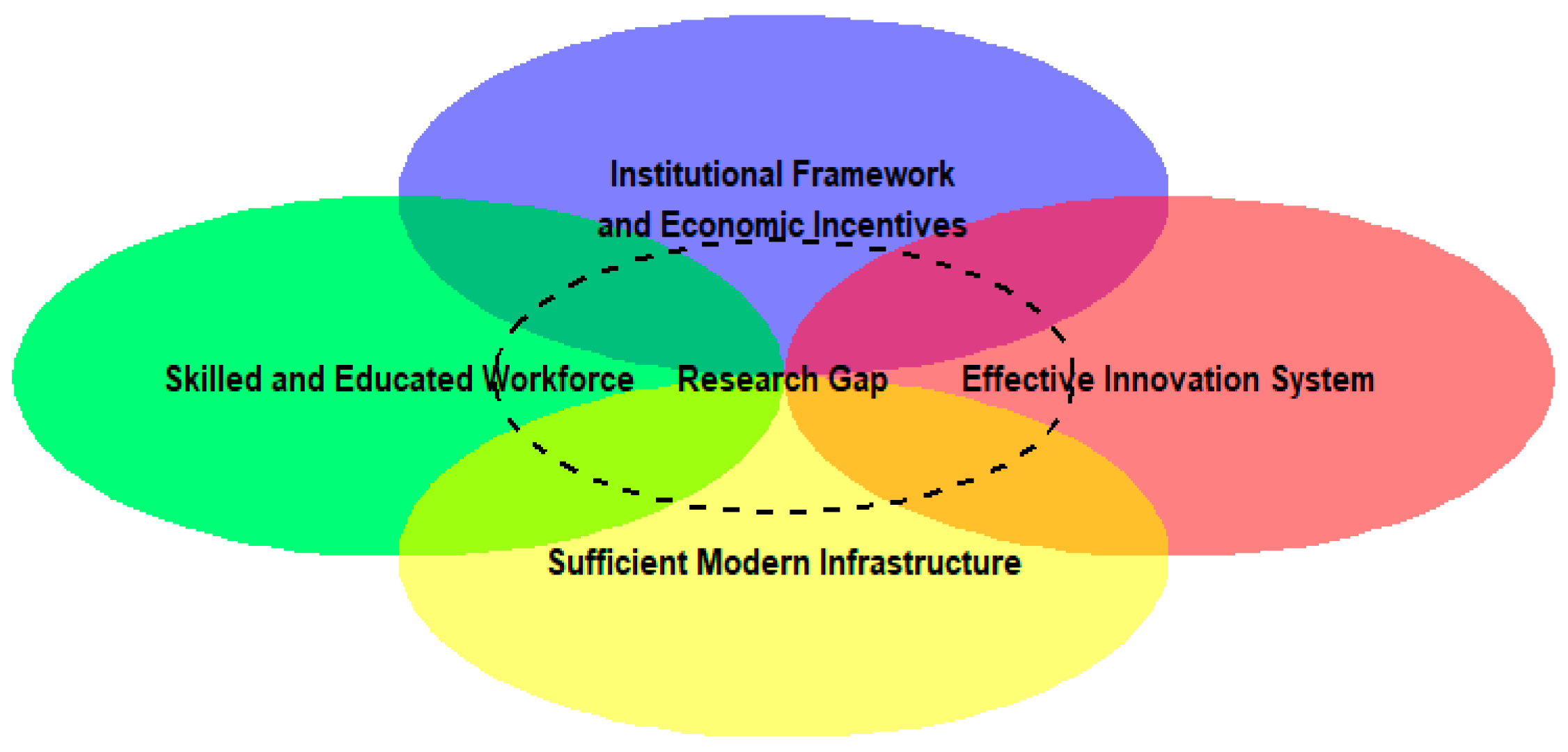
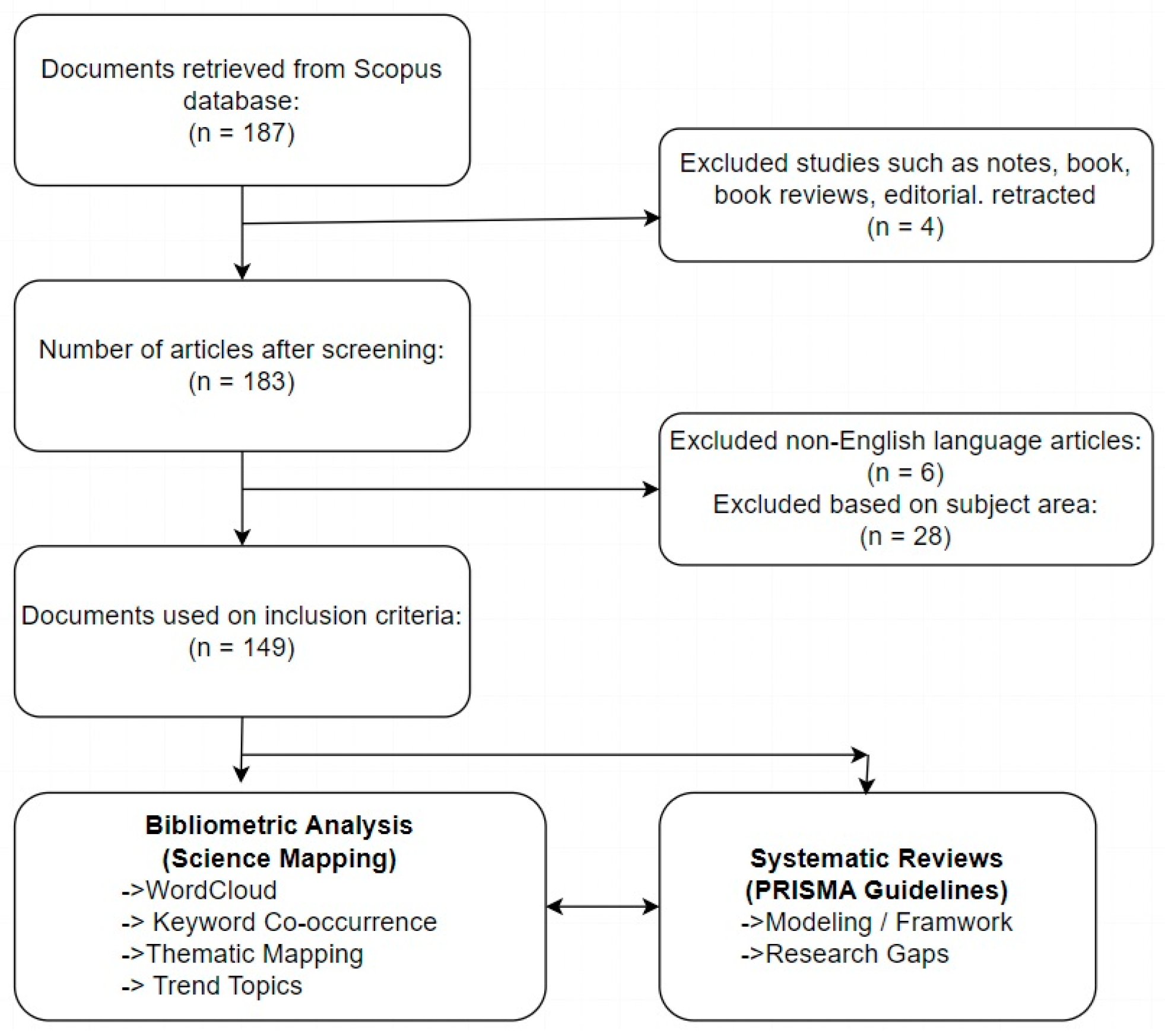
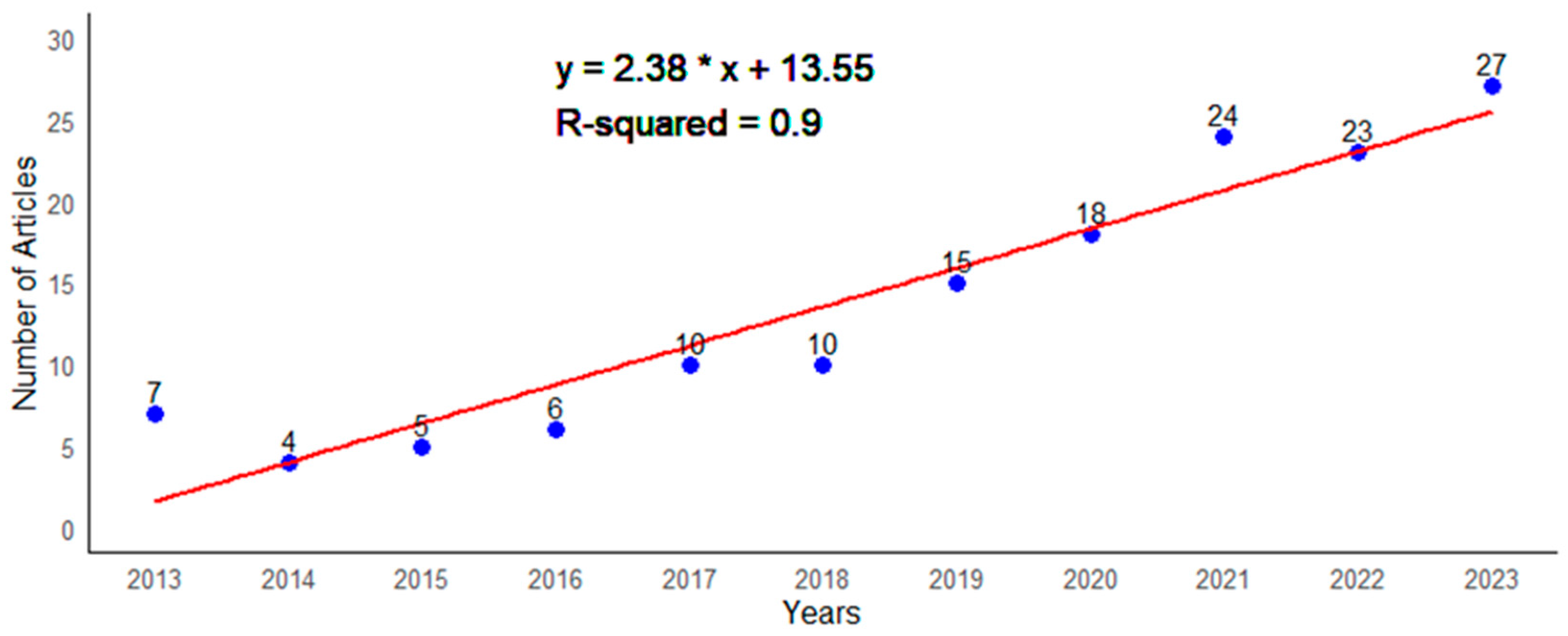
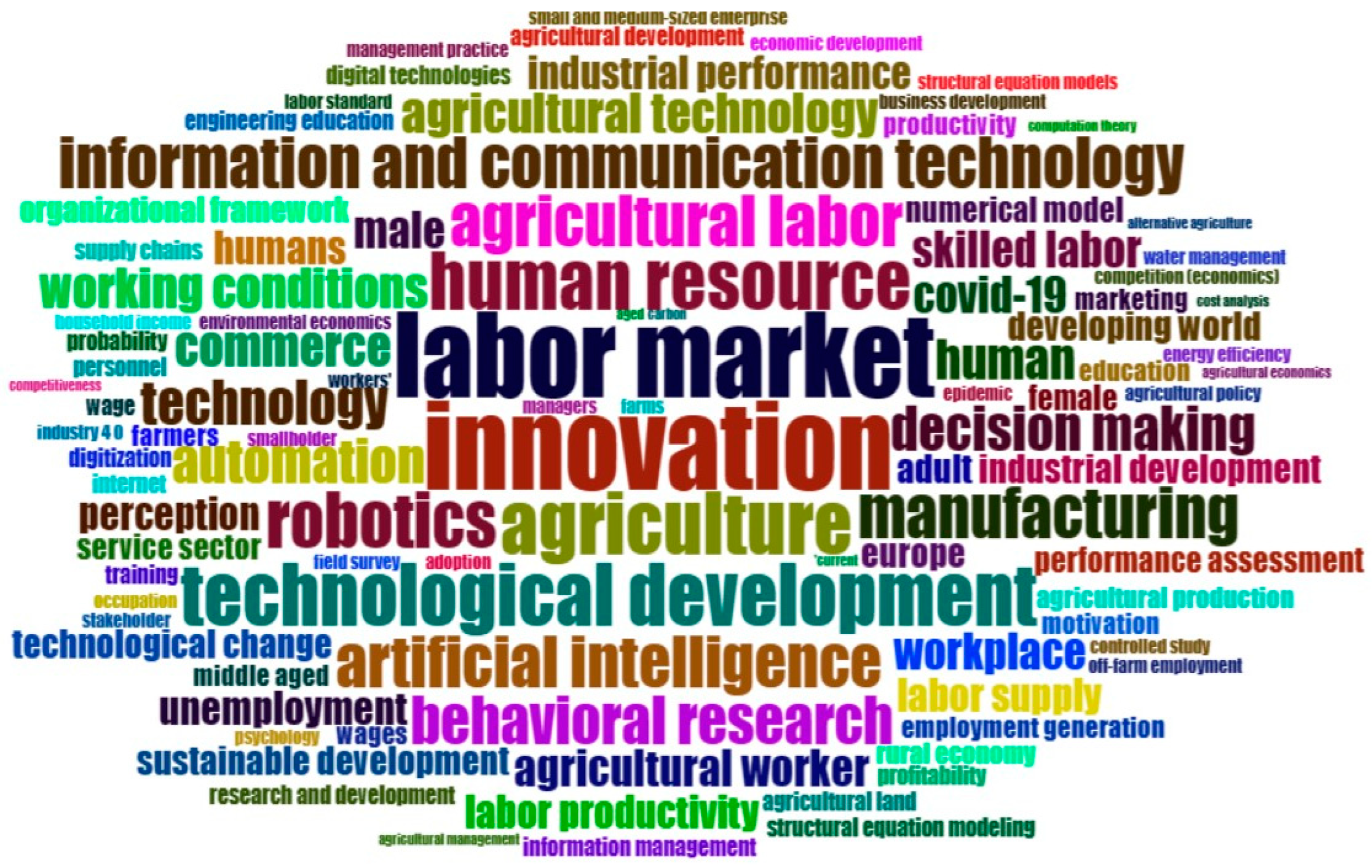
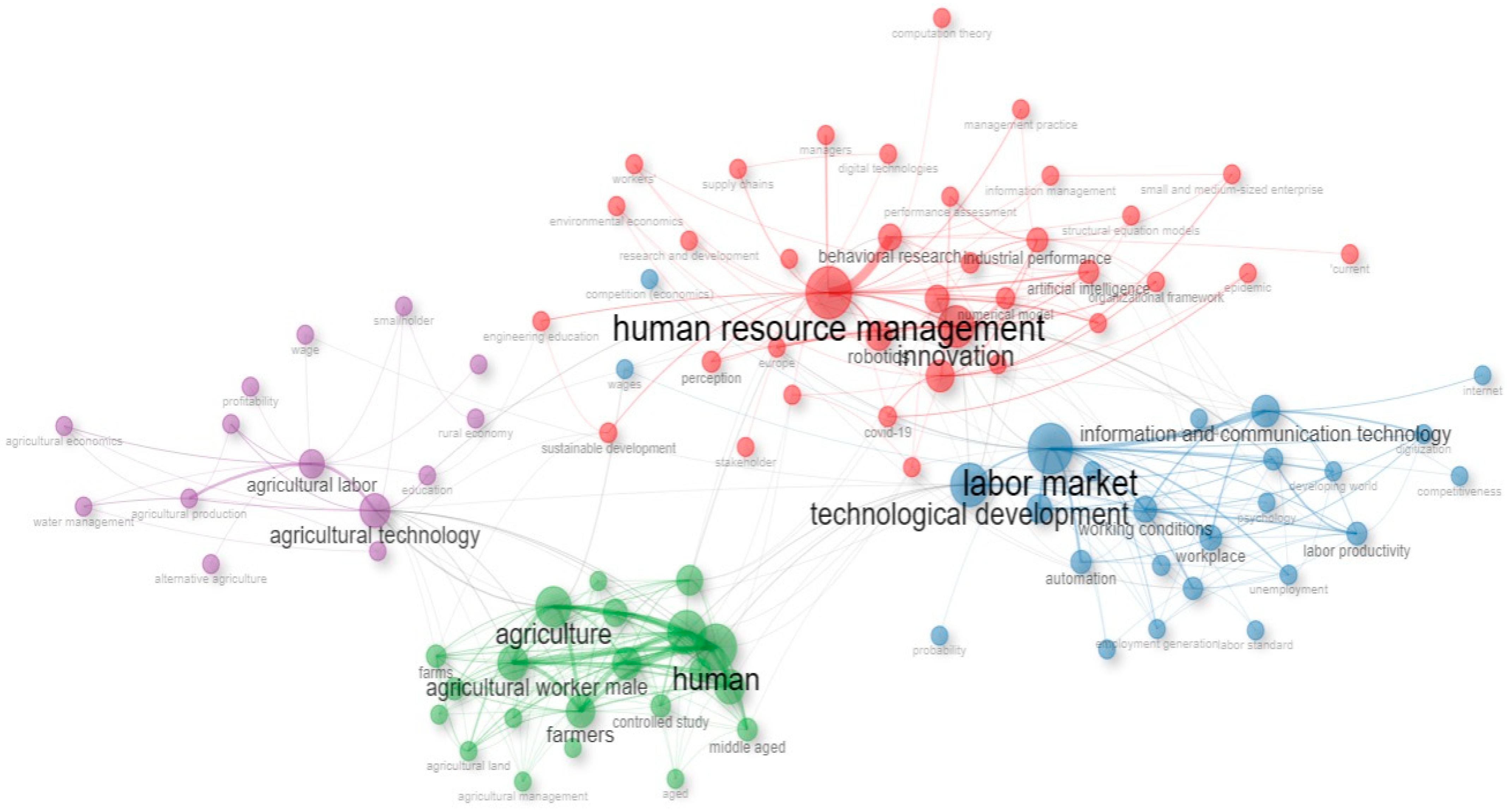
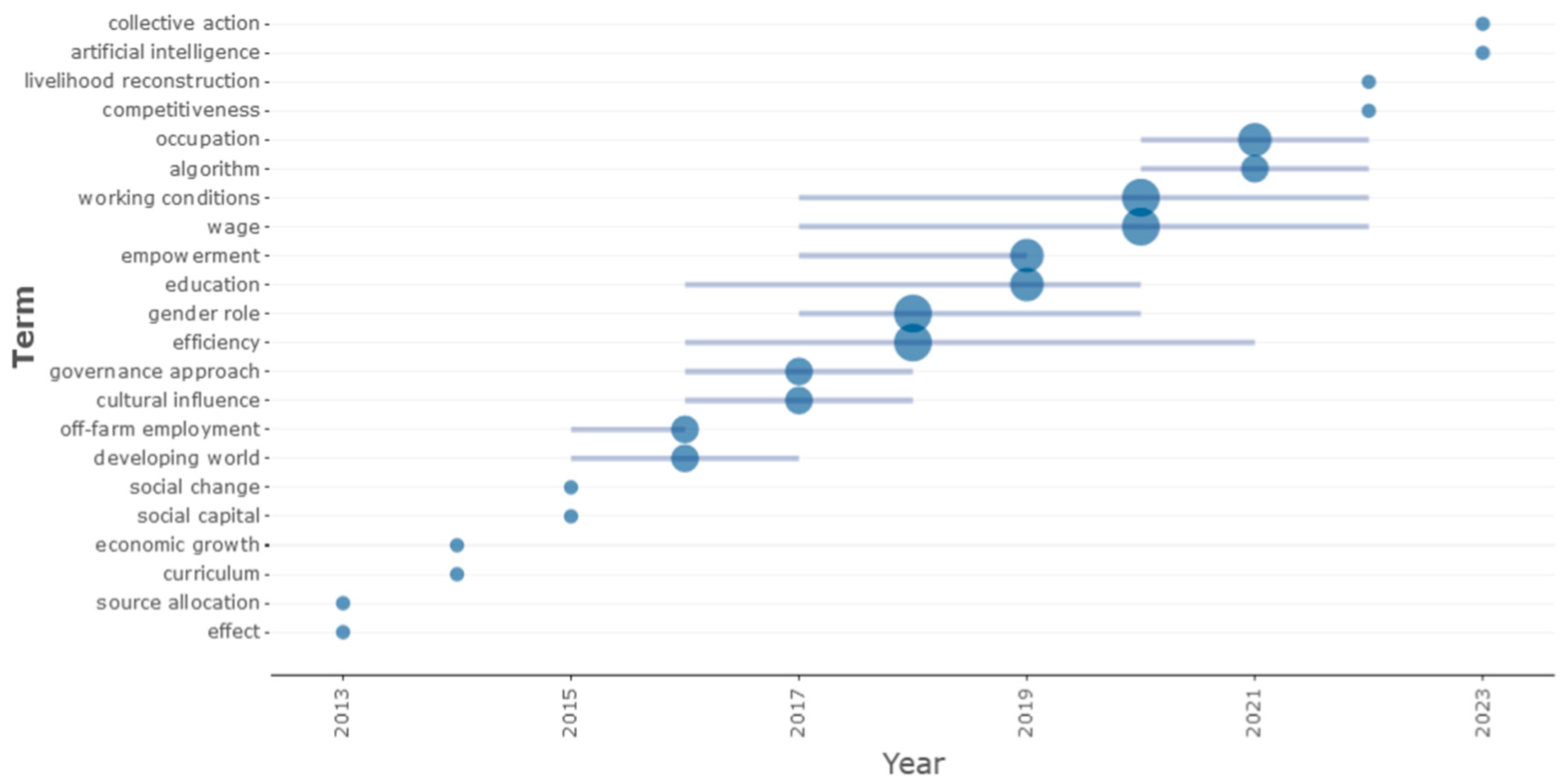
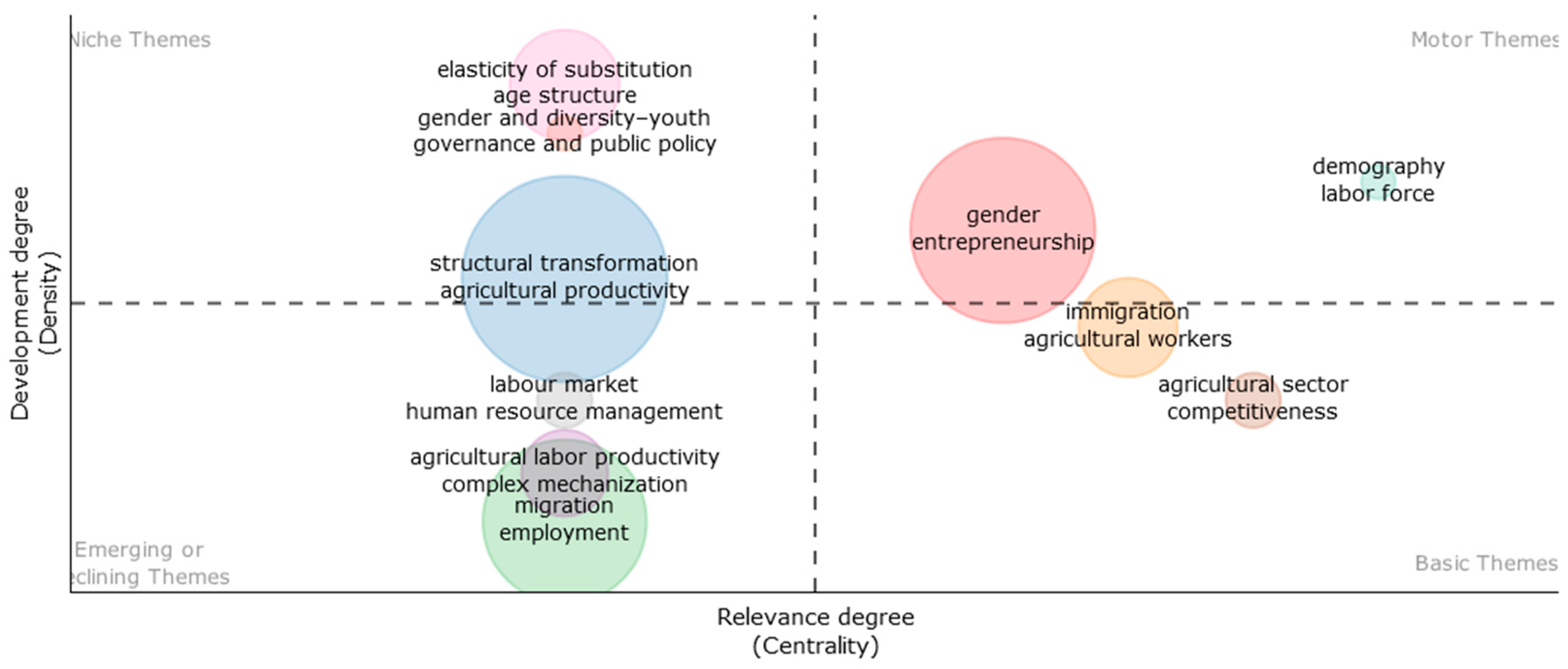
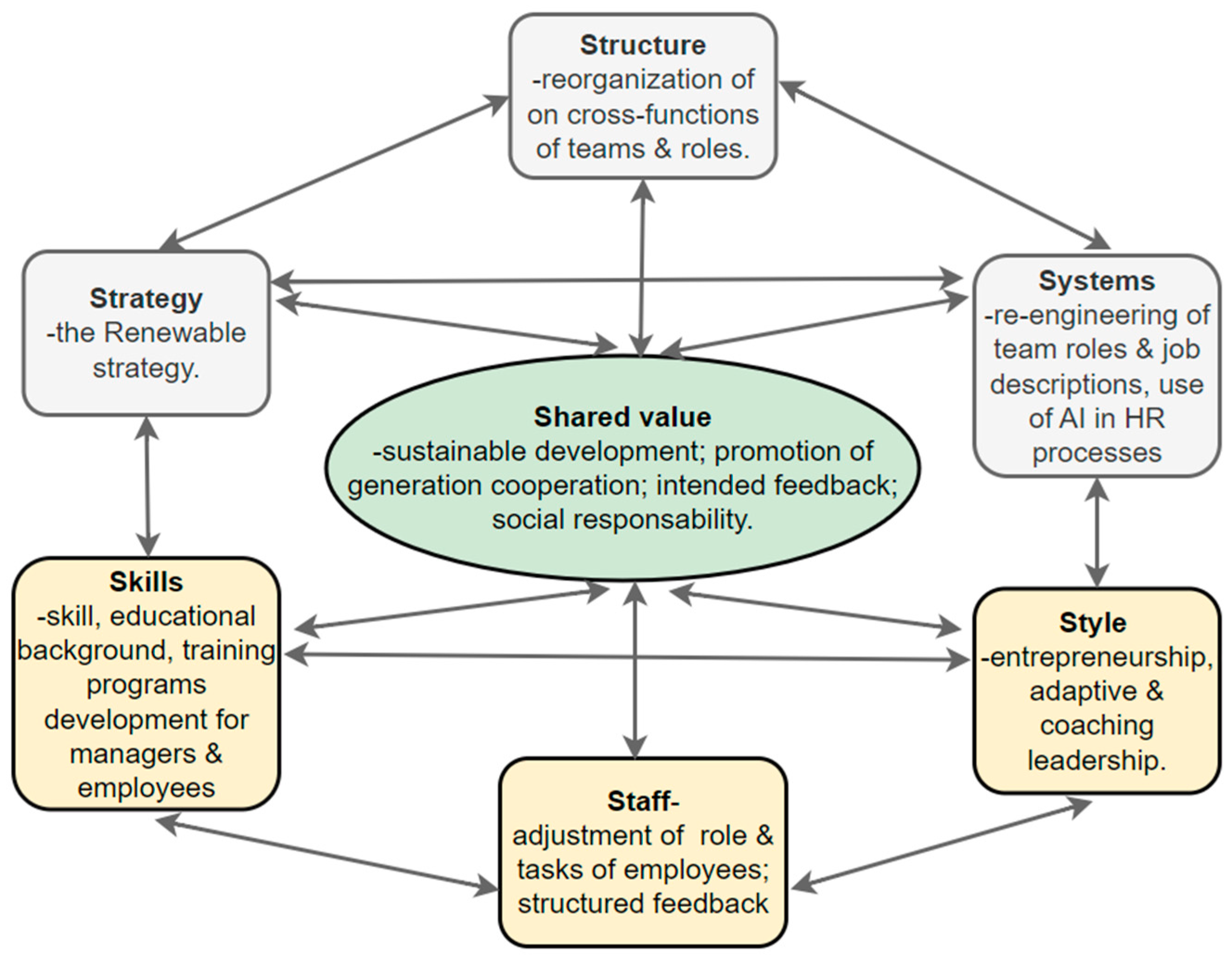
| Main HRM Functions | The Role of HRM on Technology Adoption in Agriculture: |
|---|---|
| Technology training and development | -Enables training for employees on how to utilize modern machinery before going to a job [81]. -Offers opportunities for personal development [22]. |
| Change Management | -Supports farm managers and agriculture workers to ensure smooth transitions [23]. -Addresses the resistance to change [82]. |
| Labor Allocation | -Adjusts the roles (responsibilities) and tasks for employees and matches their capabilities on farm activities [83]. |
| Sustainability Allocation | -Improves resource efficiency by setting up adequate teams [84]. -Aligns and coordinates the values of the organization’s principles with the sustainability goals (SDGs) [85]. -Improves and attracts the new generation into agriculture farm activities [86,87] driven by technology changes (ensures generation cooperation) [88]. |
| Regulatory Compliance | -Adapts and enforces technology practices [89] in compliance with current laws and regulations [90], such as cybersecurity concerns and data management concerns [18,91]. |
| Knowledge Management | -Provides adequate education matched with the new technological skill requirements [92,93,94]. -Opens new jobs and/or builds new job profiles that match the workers’ attitude (attitude hiring) [95,96]. -Facilitates and ensures adequate recruitment aligned with educational background [97]. -Develops workforce restructuring: the company addresses the challenges caused by job hoppers and ambitious people [98] by offering personal development. -Collects and assesses the intended feedback in relation to new employees (adjustment process), employee performance, and challenges coming from the teams in regard to technology adoption [99]. |
Disclaimer/Publisher’s Note: The statements, opinions and data contained in all publications are solely those of the individual author(s) and contributor(s) and not of MDPI and/or the editor(s). MDPI and/or the editor(s) disclaim responsibility for any injury to people or property resulting from any ideas, methods, instructions or products referred to in the content. |
© 2024 by the authors. Licensee MDPI, Basel, Switzerland. This article is an open access article distributed under the terms and conditions of the Creative Commons Attribution (CC BY) license (https://creativecommons.org/licenses/by/4.0/).
Share and Cite
Qorri, D.; Pergéné Szabó, E.; Felföldi, J.; Kovács, K. The Role of Human Resource Management in Agricultural Labor-Saving Technologies: An Integrative Review and Science Mapping. Agriculture 2024, 14, 1144. https://doi.org/10.3390/agriculture14071144
Qorri D, Pergéné Szabó E, Felföldi J, Kovács K. The Role of Human Resource Management in Agricultural Labor-Saving Technologies: An Integrative Review and Science Mapping. Agriculture. 2024; 14(7):1144. https://doi.org/10.3390/agriculture14071144
Chicago/Turabian StyleQorri, Dejsi, Enikő Pergéné Szabó, János Felföldi, and Krisztián Kovács. 2024. "The Role of Human Resource Management in Agricultural Labor-Saving Technologies: An Integrative Review and Science Mapping" Agriculture 14, no. 7: 1144. https://doi.org/10.3390/agriculture14071144






